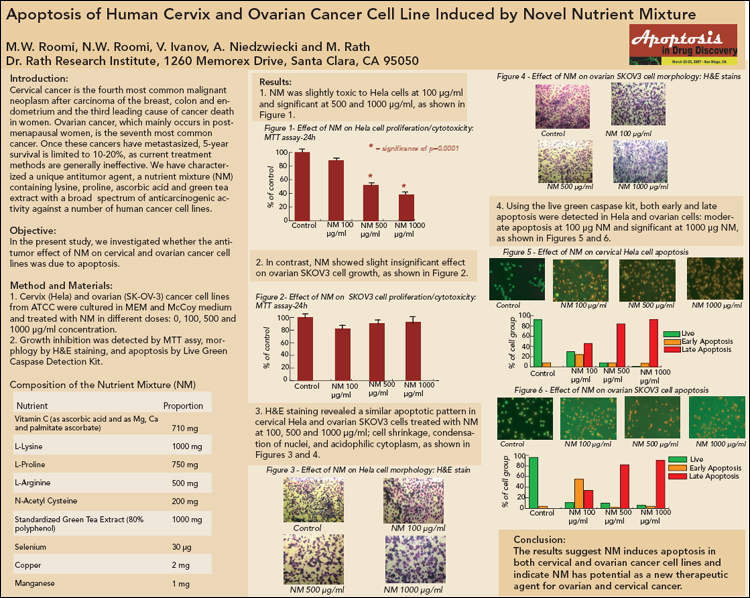M.W. Roomi, N.W. Roomi, V. Ivanov, A. Niedzwiecki and M. Rath
Dr. Rath Research Institute, 1260 Memorex Drive, Santa Clara, CA 95050
Presented at:
GTCbio Apoptosis in Drug Discovery; San Diego, CA; March 22-23, 2007
Published in:
Proceedings of the GTCbio Conference on Apoptosis in Drug Discovery
Abstract
Introduction:
Cervical cancer is the fourth most common malignant neoplasm and ovarian cancer the seventh most common. Once these cancers are metastasized, 5-year survival is limited to 10-20%. A unique antitumor agent, a nutrient mixture (NM) containing lysine, proline, ascorbic acid and green tea extract has demonstrated anticarcinogenic activity against a number of human cancer cell lines.
Objective:
We investigated whether the antitumor effect of NM on cervix and ovarian cancer cell lines was due to apoptosis.
Method and Materials:
Cervix (Hela) and ovarian (SK-OV-3) cancer cell lines from ATCC were cultured in MEM and McCoy medium and treated with NM in different doses, 0, 100, 500 and 1000 µg/ml. Growth inhibition was detected by MTT assay, morphology by H&E staining, and apoptosis by Live Green Caspase Detection Kit.
Results:
NM was slightly toxic to Hela cells at 100 µg/ml and significant at 500 and 1000 µg/ml. In contrast, NM showed slight insignificant effect on ovarian cancer cell growth. H&E staining revealed a similar apoptotic pattern in Hela and SK-OV-3 cells treated with NM at 100, 500 and 1000 µg/ml: cell shrinkage, condensation of nuclei, and acidophilic cytoplasm. Using the caspase kit, both early and late apoptosis were detected in Hela and ovarian cells: moderate at 100 µg/ml NM and significant at 1000 µg/ml NM.
Conclusions:
The results suggest that NM induces apoptosis in both cervical and ovarian cancer cell lines and thus as a promising new therapeutic agent.
Comment
A unique antitumor agent, a nutrient mixture (NM) containing lysine, proline, ascorbic acid and green tea extract has demonstrated anticarcinogenic activity against a number of human cancer cell lines, including ovarian and cervical cancer. We investigated whether the antitumor effect of NM on cervical and ovarian cancer cell lines was due to apoptosis. NM was toxic to cervical (Hela) cells but did not affect ovarian cancer (SK-OV-3) cells. However, morphology and caspase apoptosis assays indicated that NM induced apoptosis in both cells lines – moderate at 100 µg/ml and profound at 1000 µg/ml. These results are significant as they suggest that NM has therapeutic potential in treatment of ovarian and cervical cancer.
